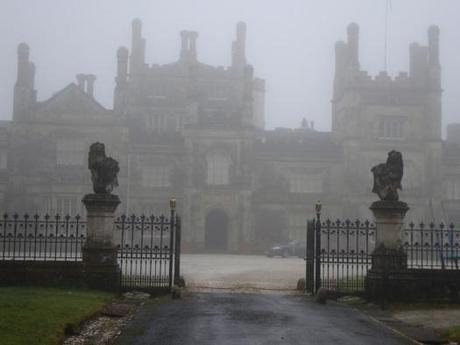
Image from here
The Little Stranger is a rare book; one that is both genuinely terrifying and also deeply emotionally involving, that left me reluctant yet desperate to turn its pages. I haven’t read anything by Sarah Waters in years; she was on my university syllabus with her first novel, Fingersmith, which I very much enjoyed, but for some reason I have never felt particularly compelled to read any more of her work. This will now change.
A modern update to that marvelous of Victorian traditions, the sensation novel, The Little Stranger tells the story of Dr Faraday, a resident of a small, backwater town in rural Warwickshire, and his relationship with the Ayres family of Hundreds Hall, the local ‘big house’. The novel starts with a sun dappled Edwardian afternoon, with Dr Faraday as a child at a Hundreds Hall Empire Day party, being impressed by the beauty and splendour of this luxurious mansion and that of its owners, the young Mrs and Colonel Ayres. His mother, a former servant at the house, takes him inside to the servants’ quarters, and he sneaks upstairs into the hushed coolness of the marble corridored, portrait hung hall. Desperate to take something of the Hall home with him, he uses his pocket knife to wrench a plaster acorn out of a decorative cornice before running back to his mother.
Flashing forward to the depressed days of post war 1940s England, Dr Faraday is now in early middle age and living above his GP practice in the same town where he grew up. A chance call out to Hundreds Hall in the absence of the family’s usual doctor gives him the opportunity to revisit the house that has held such a fascination for him since his childhood. To his dismay, the house has fallen into terrible disrepair over the years, and is barely recognisable as the grand location of the Empire Day party so many years before. Mrs Ayres, now widowed, lives in the house with her plain spinster daughter Caroline and her son Roderick, who was badly wounded in the war. They live amidst the ruins of their once fine house, keeping up appearances as best they can, but Dr Faraday soon realises that the family are under enormous financial pressure and finding it near impossible to keep things afloat.
After seeing to their servant girl, Betty, who is faking a stomach ache due to her desire to leave the house she deems ‘bad’, Dr Faraday finds himself welcomed by the Ayres family and encouraged to return to try and help Roderick regain movement in his damaged legs. As time passes, Dr Faraday becomes an increasingly frequent visitor, confided in by the family and deeply involved in their affairs. However, a series of events begins to trouble the family soon after Dr Faraday’s arrival on the scene. Betty and Roderick claim there is a ‘bad’ thing in the house. Dr Faraday refuses to believe it, but with Caroline, who he is growing to love, becoming increasingly convinced that all is not well, and the health and happiness of the house’s inhabitants growing more precarious by the day, an explanation for the events needs to be found. Is it paranoia, brought on by the stresses of maintaining Hundreds? Is it a family ‘taint’ of the mind? Or are there darker, supernatural forces at work to destroy the family and their home?
This is a novel with so many absorbing strands that it’s difficult to give an overview without missing something. Coupled with the mystery of what is really happening at Hundreds is the fascinating context of post war England. Hundreds’ park has had to be sold to the council to recoup money, and council houses have been built right up to the garden wall, a perfect metaphor for the decline of the aristocracy and the country house after the war. Dr Faraday is anxious about the coming of the NHS, and what that will do to his practice. The town is flat, depressed, unsophisticated; in a world of ration coupons, poverty, unemployment and poor housing, the highlight of Dr Faraday’s social calendar is the local hospital dance. The decaying surroundings of Hundreds add to this gloomy outlook, representing effortlessly the state of a country newly emerged from the shadows of another devastating war. Amidst all of this period detail, the reader is asked to decipher what exactly is going on at Hundreds Hall. Is it madness? Is it the ghost of a former inhabitant? Or, as the final lines tantalisingly suggest, is the answer a little closer to home? Read it and decide for yourself…
